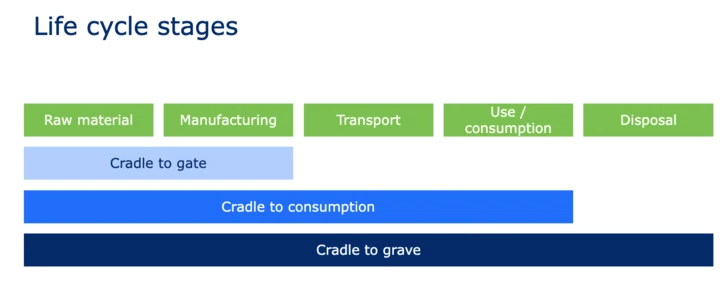GS1 Synkka – Storing carbon footprint data
The carbon footprint value is the information calculated for the product in question. If the information is printed on the packaging, it must be reported. The information can be provided even if it is not printed on the packaging.
For the Fast-Moving Consumer Goods (FMCG) products, the Natural Resources Institute Finland (Luke) guidelines on calculating the carbon footprint must be taken into account.
The following information is always provided about the carbon footprint:
- Carbon Footprint Country Code
- Carbon Footprint Date
- Carbon Footprint Value Verification Code
- Carbon Footprint Boundaries Code
- Carbon Footprint Value and unit of measurement
- Carbon Footprint Methodology Code
Depending on the information provided, the following information is provided:
- Carbon Footprint Functional Unit
Optional information:
- Carbon Footprint Accounting Code
- Trade Item Sustainability Statement
Carbon Footprint Country Code
Carbon Footprint Country Code (id 7042) tells which country's values, e.g. the transportation share, have been calculated. Save only one destination country for the carbon footprint value.
Product sold domestically in Finland: indicate Finland as the destination country.
Export product: indicate the destination country and calculate logistics according to that country. Please note any differences in the destination country's guidelines for calculating carbon footprint.
Carbon Footprint Date
Carbon Footprint Date (id 7044) can be used to indicate the year in which the calculation method was used to calculate the product, or the year in which the product value was calculated.
If the calculation was performed on several days, indicate the last day. You can use 00.00.00 as the time.
Carbon Footprint Value Verification Code
Carbon Footprint Value Verification Code (id 7043) indicates how the reported values have been verified. Verification confirms that the calculation has been done correctly. Different calculation methods may have specifications on how they should be verified.
Not verified: The values have been calculated according to the reported calculation method, but the values and method have not been verified.
Peer reviewed: The values and methods have been checked internally or by a third party, but the verifier has not been authorized.
External verification: The values and methods have been verified by an external party, an authorized verifier – recommended method.
Carbon Footprint Boundaries Code
Carbon Footprint Boundaries Code (id 7045) defines whether the value to be given is the value of a specific life cycle stage or a whole. Products from different product groups may have differences in the life cycle stages that are reported.
If individual life cycle stages are reported, all stages should be reported separately.
The use of the product, e.g. the carbon footprint of a washing cycle, can be reported as a single life cycle stage.
Raw materials: includes cultivation, collection, transportation, possible intermediate products
Manufacturing: manufacturing the product
Transport of final product: logistics values of the finished product
Use: emissions from the use and consumption of the product
End of life: emissions from the disposal of the product
Entities of life cycle stages
Cradle to gate includes raw material and manufacturing
Cradle to consumption includes raw material, manufacturing, transportation and use. (Luke recommendation)
Cradle to grave includes all stages of the life cycle
Carbon Footprint Functional Unit
Carbon Footprint Functional Unit (id 7047) specify the functional unit if the unit of measurement used is:
Kg CO2eq per functional unit and the life cycle stage is Use.
Please state for which function and with which attributes the carbon footprint is reported. This is a free text field, you define the information to be provided yourself.
E.g. carbon footprint of a washing cycle
Carbon Footprint Methodology Code
Carbon Footprint Methodology Code (id 7048) field, state the calculation method used to calculate the values. If more than one method was used in the calculation, state the most dominant method as the calculation method.
The different stages of the product's life cycle should, if possible, be calculated using the same calculation method.
Carbon Footprint Accounting Code
Carbon Footprint Accounting Code (id 7049) indicates whether the calculation takes into account only the product's impacts or also the broader environmental impacts. This is optional information.
Attributional (ALCA): product impact – recommended method
Consequential (CLCA): broader environmental impact
Trade Item Sustainability Statement
Trade Item Sustainability Statement (id 5116) allows you to provide further information related to the calculation, e.g. what instructions were used to calculate the values. This is optional information.


